Lablab bean
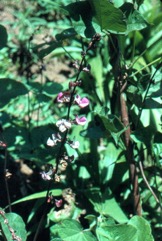
It is a tropical and subtropical plant. It mostly grows between 750 and 2175 m altitude in the tropics. It is drought resistant and can grow in quite low rainfall areas. Some varieties are short day and some are long day kinds. In Nepal it grows to about 2500 m altitude. It suits hardiness zones 9-12. In Yunnan.
Also known as:
Antaka, Ataka, Avara, Avarai, Awuje, Bach bien dau, Bak pap, Bepi, Bian dou, Bonavist bean, By-lap, Carmelita, Caruana, Chapparada avare, Chikkudu, Cinkamba, Coelhinho, Dau van, Dolic, Dralawa, Fagiolo egiziano, Feijao, Frijol caballero, Fuji mame, Habichuela, Helmbohne, Hiunde simi, Hyacinth bean, 'itab, Kacang kara, Kachang jeriji, Kachang kara, Kara-kara, Kattuavaral, Kekara, Khungudzi, Mbumbu, Munkamba, Ngiima, Nhaperepere, Nwai-pe, Nzavi, Papuri, Pavta, Pe-letma, Pe-maung-makaw, Pe-pazum, Pe-seik-gyo, Pe-wa-kyeik, Pe-wet-swe, Roway katopes, Samdaek holann tao, Sem, Shim, Sokol, Toba, To-tat, Tua nang, Tua pep, Tua-paep, Umuharakuuki, Val, Waken baibayi
Synonyms
- Lablab niger Medik
- Dolichos benghalensis Jacq.
- Dolichos lablab L.
- Lablab purpurea (L.) Sweet
- Lablab vulgaris (L.) Savi
- Dolichos purpureus L.
- Vigna aristata Piper
Edible Portion
- Leaves, Pods, Seeds, Root, Flowers, Vegetable
Where does Lablab bean grow?
Found in: Africa, Angola, Antigua-Barbuda, Asia, Australia, Bahamas, Bahrain, Bangladesh, Barbados, Belize, Benin, Bhutan, Botswana, Brazil, Burkina Faso, Burundi, Cambodia, Cameroon, Canada, Cape Verde, Central Africa, Central African Republic, CAR, Central America, Chad, China, Congo, Côte d'Ivoire, Cuba, Dominican Republic, East Africa, East Timor, Easter Island, Egypt, El Salvador, Eritrea, Eswatini, Ethiopia, Fiji, French Guiana, Gabon, Gambia, Ghana, Grenada, Guadeloupe, Guianas, Guinea, Guinée, Guinea-Bissau, Guyana, Haiti, Hawaii, Himalayas, India, Indochina, Indonesia, Iran, Iraq, Ivory Coast, Jamaica, Kenya, Laos, Liberia, Madagascar, Malawi, Malaysia, Maldives, Mali, Marquesas, Martinique, Mauritania, Mauritius, Mexico, Mozambique, Myanmar, Namibia, Nauru, Nepal, Nicaragua, Niger, Nigeria, Norfolk Island, North Africa, North America, Northeastern India, Oman, Pacific, Pakistan, Panama, Papua New Guinea, PNG, Peru, Philippines, Puerto Rico, Reunion, Rwanda, Saudi Arabia, SE Asia, Seychelles, Senegal, Sierra Leone, Sikkim, Singapore, Slovenia, South Africa, Southern Africa, South America, Sri Lanka, Sudan, Suriname, Swaziland, Taiwan, Tanzania, Tasmania, Thailand, Timor-Leste, Togo, Tonga, Uganda, United States, Vanuatu, Venezuela, Vietnam, West Africa, West Indies, Yemen, Zambia, Zimbabwe
Notes: There is only one Lablab species. Also as Papilionaceae.
Status: It is a commercially cultivated vegetable. A traditional bean common and quite widely used in some Highland areas of Papua New Guinea.
Growing Lablab bean
Cultivation: Seeds are sown at 30 x 60 cm spacing near stakes or trees. About 20 kg of seed per hectare are required. Fertilising with nitrogen and potash until flowering is recommended. Young pods are ready 4-6 months after planting and seeds 6-8 months. Pods are often harvested over 2 or 3 years. Pollination and seed setting are reduced in cold weather.
Edible Uses: The young pods, ripe seeds and young leaves are edible, cooked. Flowers can be eaten raw, steamed or added to soups and stews. Dried seeds can be cooked as a vegetable. The seeds can also be sprouted then crushed and cooked. The large starchy root is edible. CAUTION Many types can be poisonous. They should be boiled and the cooking water thrown away.
Production: Young pods are ready 4-6 months after planting and seeds 6-8 months. Pods are often harvested over 2 or 3 years. Pollination and seed setting are reduced in cold weather.
Nutrition Info
per 100g edible portion| Edible Part | Energy (kcal) | Protein (g) | Iron (mg) | Vitamin A (ug) | Vitamin c (mg) | Zinc (mg) | % Water |
|---|---|---|---|---|---|---|---|
| Seeds - dry | 342 | 22.8 | 9 | - | Tr | - | 10 |
| Fresh Pods | 49 | 3.9 | 2.4 | - | 1 | - | 86.7 |
| Seeds - young | 50 | 3 | 0.8 | 14 | 5.1 | 0.4 | 86.9 |
Lablab bean Photos

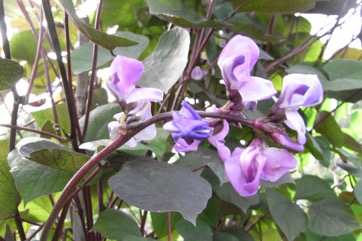
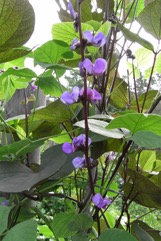
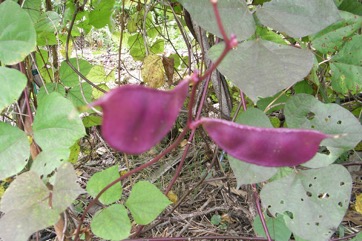
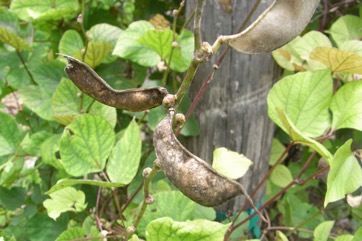
References
Adebisi, A.A. & Bosch, C.H., 2004. Lablab purpureus (L.) Sweet. [Internet] Record from Protabase. Grubben, G.J.H. & Denton, O.A. (Editors). PROTA (Plant Resources of Tropical Africa), Wageningen, Netherlands. < http://database.prota.org/search.htm>. Accessed 16 October 2009.
Ambasta, S.P. (Ed.), 2000, The Useful Plants of India. CSIR India. p 182 (As Dolichos lablab)
Anderson, E. F., 1993, Plants and people of the Golden Triangle. Dioscorides Press. p 210 (As Dolichos lablab)
Ara, R. I. T., 2015, Leafy Vegetables in Bangladesh. Photon eBooks. p 134
Bailey, F. M., 1913, Comprehensive Catalogue of Queensland Plants. Queensland Government. p 144 (As Dolichos lablab)
Bodner, C. C. and Gereau, R. E., 1988, A Contribution to Bontoc Ethnobotany. Economic Botany, 43(2): 307-369
Brickell, C. (Ed.), 1999, The Royal Horticultural Society A-Z Encyclopedia of Garden Plants. Convent Garden Books. p 586
Brouk, B., 1975, Plants Consumed by Man. Academic Press, London. p 79
Burkill, I.H., 1966, A Dictionary of the Economic Products of the Malay Peninsula. Ministry of Agriculture and Cooperatives, Kuala Lumpur, Malaysia. Vol 1 (A-H) p 864 (As Dolichos lablab)
Burnie, G.(Ed.), 2003, Annuals and Bulbs. The Gardener's Handbooks. Fog City Press. p 177
Chin, H. F., 1999, Malaysian Vegetables in Colour. Tropical Press. p 25 (As Dolichos lablab)
Cobley, L.S. (rev. Steele, W.M.) 2nd Ed., 1976, An Introduction to the Botany of Tropical Crops. Longmans. p 96
Cundall, P., (ed.), 2004, Gardening Australia: flora: the gardener's bible. ABC Books. p 786
Dangol, D. R. et al, 2017, Wild Edible Plants in Nepal. Proceedings of 2nd National Workshop on CUAOGR, 2017. (As Dolichos lablab)
Facciola, S., 1998, Cornucopia 2: a Source Book of Edible Plants. Kampong Publications, p 106
FAO, 1988, Traditional Food Plants, FAO Food and Nutrition Paper 42. FAO Rome p 337
Flora of Australia Volume 49, Oceanic Islands 1, Australian Government Publishing Service, Canberra. (1994) p 185
Flora of Pakistan. www.eFloras.org
Foo, J.T.S.(ed), 1996, A Guide to Common Vegetables. Singapore Science Foundation. p 82
Fowler, D. G., 2007, Zambian Plants: Their Vernacular Names and Uses. Kew. p 38
French, B.R., 1986, Food Plants of Papua New Guinea, A Compendium. Asia Pacific Science Foundation p 35
French, B.R., 2010, Food Plants of Solomon Islands. A Compendium. Food Plants International Inc. p 47
Gangte, H. E., et al, 2013, Wild Edible Plants used by the Zou Tribe in Manipur, India. International Journal of Scientific and Research Publications, Volume 3, Issue 5 (As Dolichos lablab)
Grubben, G. J. H. and Denton, O. A. (eds), 2004, Plant Resources of Tropical Africa 2. Vegetables. PROTA, Wageningen, Netherlands. p 343
Guite, C., 2016, A study of wild edible plants associated with the Paite tribe of Manipur, India, International Journal of Current Research. Vol. 8, Issue, 11, pp. 40927-40932 (As Dolichos lablab)
Hedrick, U.P., 1919, (Ed.), Sturtevant's edible plants of the world. p 280 (As Dolichos lablab)
Hort. brit. ed. 1:481. 1826
Hu, Shiu-ying, 2005, Food Plants of China. The Chinese University Press. p 475
ILDIS Legumes of the World http:www:ildis.org/Legume/Web
Jardin, C., 1970, List of Foods Used In Africa, FAO Nutrition Information Document Series No 2.p 25, 85
Kays, S. J., and Dias, J. C. S., 1995, Common Names of Commercially Cultivated Vegetables of the World in 15 languages. Economic Botany, Vol. 49, No. 2, pp. 115-152
Kiple, K.F. & Ornelas, K.C., (eds), 2000, The Cambridge World History of Food. CUP p 1788
Kuo, W. H. J., (Ed.) Taiwan's Ethnobotanical Database (1900-2000), http://tk.agron.ntu.edu.tw/ethnobot/DB1.htm (As Dolichos lablab)
Larkcom, J., 1991, Oriental Vegetables, John Murray, London, p 59
Lazarides, M. & Hince, B., 1993, Handbook of Economic Plants of Australia, CSIRO. p 143
Lembogi Biologi Nasional, 1980, Sayur-sayuran. Balai Pustaka, Jakarta. p 50
Lim, T. K., 2015, Edible Medicinal and Non Medicinal Plants. Volume 9, Modified Stems, Roots, Bulbs. Springer p 50
Liu, Yi-tao, & Long, Chun-Lin, 2002, Studies on Edible Flowers Consumed by Ethnic Groups in Yunnan. Acta Botanica Yunnanica. 24(1):41-56
Long, C., 2005, Swaziland's Flora - siSwati names and Uses http://www.sntc.org.sz/flora/
Macmillan, H.F. (Revised Barlow, H.S., et al) 1991, Tropical Planting and Gardening. Sixth edition. Malayan Nature Society. Kuala Lumpur. p 325
Manandhar, N.P., 2002, Plants and People of Nepal. Timber Press. Portland, Oregon. p 282
Massal, E. and Barrau, J., 1973, Food Plants of the South Sea Islands. SPC Technical Paper No 94. Nounea, New Caledonia. p 30
Maundu, P. et al, 1999, Traditional Food Plants of Kenya. National Museum of Kenya. 288p
McMakin, P.D., 2000, Flowering Plants of Thailand. A Field Guide. White Lotus. p 96 (As Dolichos lablab)
Medhi, P. & Borthakur, S. K., 2012, Phytoresources from North Cachur Hills of Assam -3: Edible plants sold at Hflong market. Indian Journal or Natural Products and Resources. 3(1) pp 84-109 (As Dolichos lablab)
Miguel, E., et al, 1989, A checklist of the cultivated plants of Cuba. Kulturpflanze 37. 1989, 211-357
Molla, A., Ethiopian Plant Names. http://www.ethiopic.com/aplants.htm
Mutie, F. G., 2020, Conservation of Wild Food Plants and Their Potential for Combatting Food Insecurity in Kenya as Exemplified by the Drylands of Kitui County. Plants 2020, 9, 1017
Ochse, J.J. et al, 1931, Vegetables of the Dutch East Indies. Asher reprint. p 382 (As Dolichos lablab)
Omawale, 1973, Guyana's edible plants. Guyana University, Georgetown p 103
Paczkowska, G . & Chapman, A.R., 2000, The Western Australian Flora. A Descriptive Calatogue. Western Australian Herbarium. p 438
Peters, C. R., O'Brien, E. M., and Drummond, R.B., 1992, Edible Wild plants of Sub-saharan Africa. Kew. p 134
Pham-Hoang Ho, 1999, An Illustrated Flora of Vietnam. Nha Xuat Ban Tre. p 956
Phon, P., 2000, Plants used in Cambodia. © Pauline Dy Phon, Phnom Penh, Cambodia. p 393
Plants for a Future database, The Field, Penpol, Lostwithiel, Cornwall, PL22 0NG, UK. http://www.scs.leeds.ac.uk/pfaf
Plants of Haiti Smithsonian Institute http://botany.si.edu/antilles/West Indies
Polunin, O., & Stainton, A., 2006, Flowers of the Himalaya, Oxford India Paperbacks. p 102
Pradhan, R., et al, 2020, Potential Wild Edible Plants and its Significance in Livelihood of Indigenous People of Male Mahadeshwara Hills, Karnataka. Economic Affairs Vol. 64, No. 4 pp. 01-14
Prafulla, S., 2017, Wild Food Diversity of Nawegaon-Nagzira Tiger Reserve in Gondia-Bhandara district of Maharashtra, India. Int. J. of Life Sciences, 2017, Vol. 5 (4): 620-626
Purseglove, J.W., 1968, Tropical Crops Dicotyledons, Longmans. p 272
Rashid, H. E., 1977, Geography of Bangladesh. Westview. p 262 (As Dolichos lablab)
Ramachandran, V.S. and Nair, V.J., 1981, Ethnobotanical studies in Cannanore District, Kerala State (India). J Econ. Tax. Bot. Vol 2 pp 65-72
Recher, P, 2001, Fruit Spirit Botanical Gardens Plant Index. www.nrg.com.au/~recher/ seedlist.html p 2 (As Dolichos lablab)
Ruiters-Welcome, A. K., 2019, Food plants of southern Africa. Ph.D. thesis. Univ. of Johannesburg p 58
Shah, S. K., 2014, Dietary contribution of underutilized minor crops and indigenous plants collected from uncultivated lands and forests in Nepal. in Promotion of Underutilized Indigenous Food Resources for Food Security and Nutrition in Asia and Pacific. FAO. Bangkok p 64 (As Dolichos lablab)
Sharma, B.B., 2005, Growing fruits and vegetables. Publications Division. Ministry of Information and broadcasting. India. p 145
Sillitoe, P. 1995, An Ethnobotanical Account of the Plant Resources of the Wola Region, Southern Highlands Province, Papua New Guinea. J. Ethnobiol. 15(2): 201-235 (As Lablab niger)
Small, E., 2009, Top 100 Food Plants. The world's most important culinary crops. NRC Research Press. p 301
Smith, P.M., 1979, Lablab, in Simmonds, N.W., (ed), Crop Plant Evolution. Longmans. London. p 311
Srichaiwong, P., et al, 2014, A Study of the Biodiversity of Natural Food Production to Support Community Upstream of Chi Basin, Thailand. Asian Social Science 10 (2):
Staples, G.W. and Herbst, D.R., 2005, A tropical Garden Flora. Bishop Museum Press, Honolulu, Hawaii. p 318
Sukenti, K., et al, 2016, Ethnobotanical study on local cuisine of the Sasak tribe in Lombok Island, Indonesia. Journal of Ethnic Foods. 3 (2016) 189-200 p 198
Swaziland's Flora Database http://www.sntc.org.sz/flora
Tanaka, Y & Van Ke, N., 2007, Edible Wild Plants of Vietnam. Orchid Press. p 78
Terra, G.J.A., 1973, Tropical Vegetables. Communication 54e Royal Tropical Institute, Amsterdam, p 44
Thaman, R.R., 1976, The Tongan Agricultural System, University of the South Pacific, Suva, Fiji. p 396
Tindall, H.D., 1983, Vegetables in the Tropics, Macmillan p 268
Tredgold, M.H., 1986, Food Plants of Zimbabwe. Mambo Press. p 11
USDA, ARS, National Genetic Resources Program. Germplasm Resources Information Network - (GRIN). [Online Database] National Germplasm Resources Laboratory, Beltsville, Maryland. Available: www.ars-grin.gov/cgi-bin/npgs/html/econ.pl (10 April 2000)
van Wyk, B., 2005, Food Plants of the World. An illustrated guide. Timber press. p 221
van Wyk, Be., & Gericke, N., 2007, People's plants. A Guide to Useful Plants of Southern Africa. Briza. p 68
van Wyk, Ben-Erik, 2019, The diversity and multiple uses of southern African legumes. Australian Systematic Botany, 2019, 32, 519–546
Verdcourt, B., 1979, Manual of New Guinea Legumes. Botany Bulletin No 11, Division of Botany, Lae, Papua New Guinea. p 536
Walter, A. & Lebot, V., 2007, Gardens of Oceania. ACIAR Monograph No. 122. p 202
Williamson, J., 2005, Useful Plants of Malawi. 3rd. Edition. Mdadzi Book Trust. p 147
Woodward, P., 2000, Asian Herbs and Vegetables. Hyland House. p 84
World Checklist of Useful Plant Species 2020. Royal Botanic Gardens, Kew
Yuncker, T.G., 1959, Plants of Tonga, Bernice P. Bishop Museum, Hawaii, Bulletin 220. p 150
Zizka, G., 1991, Flowering Plants of Easter Island. Palmarum Hortus Francofurtensis